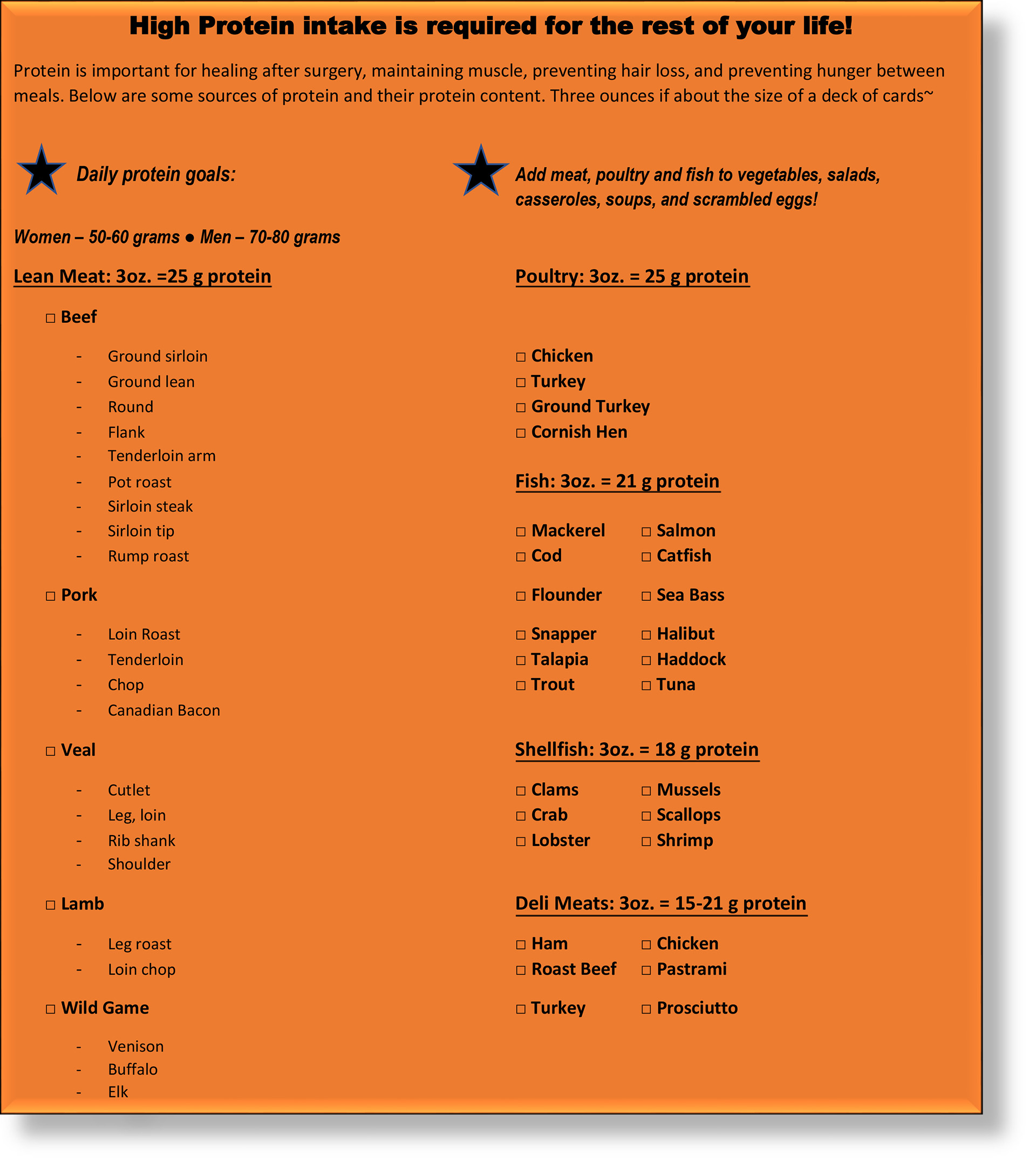Diet and Lifestyle after Weight Loss

Obesity trends among U.S. adults

Diet
With bariatric surgery, you’ll learn a whole new, healthy way of eating. And enjoy it. And not be hungry. And be successful with your weight loss and health improvement. It’s all about a healthy lifestyle and being happy. In short, you’ll love it!
Post-Op Bariatric Diet
Phase 1: Clear liquids days 1 and 2
- Water, dilute juice, sugar free jello, sugar-free popsicles and tea, Crystal Light, broth, unsweetened or artificially sweetened decaf tea or coffee, vitamin water, nestle splash, Bai, Powerade/Gatorade zero, Propel, Mio, low-calorie beverages (<10 calories per 8 ounces)
Phase 2: drinkable full liquids days 3-14
- Thin yogurt, low-fat creamy soups, milk (Skim or 1%), protein shakes (15-30 grams protein, < 15 grams sugar), smoothies, BariWise and Pantry Selections (pourable, without chunks soups)
Phase 3: pureed foods weeks 3 and 4 (and maybe 5)
- Runny eggs, low-sugar apple sauce, cottage cheese, pureed meats and fish, refried beans, and anything you can puree to the consistency of baby food.
Phase 4: regular foods one month and beyond
- Start with soft, healthy foods including fish, canned chicken or tuna, soups, veggies, and beans. Only try one new food at a time, and go very slowly. Small bites. Small amounts. Emphasize protein. Initially, avoid chewier or drier meat, such as chicken breast and steak.
Note that for the laparoscopic adjustable gastric band, there are some differences in the progression of the diet, and some foods which are off limits. The band diet is more restrictive than the sleeve and bypass diet. These differences will be discussed with you if you elect to have the laparoscopic adjustable gastric band. Also, the Orbera intragastric balloon has its own diet. See separate page on this website.

Eating Tips after Bariatric Surgery
- Do not drink liquids during meals. Wait 30 minutes after eating to drink again.
- Chew, chew, chew.
- Eat slowly. Take 30 minutes to eat your meal.
- Choose proteins first, then fats and carbs.
- Grazing and snacking, poor food choices at meals, and not exercising can sabotage your weight loss.
- Initially, breads are difficult to eat unless toasted.
- Sugar free doesn’t mean calorie free. And there’s no such thing as diet ice cream.
- Sugar, simple carbs, and starchy foods can cause the dumping syndrome. High fat or greasy foods can cause immediate diarrhea.
- Avoid carbonated drinks. It will cause discomfort and excess gas.
- Avoid gulping and swallowing air when you eat. Otherwise, you may have discomfort and a lot of gas.
- Some medications may need to be chewable, crushed, or converted to liquid or capsule forms in the first month after bariatric surgery. In general, if the pill is small enough to fit into a regular sized straw, you can just swallow it.
- Initially, use chewable or liquid vitamins and calcium. But don’t forget to change to regular, adult multivitamins and calcium within 2 months after surgery.
- Go to support group. Other patients understand the changes in your life and can help you.
Vitamins and Mineral Supplements
Patients will need to take supplements every day for the rest of your life to prevent deficiencies. For the first 4 weeks after surgery, supplements need to be chewable, liquid, powder, crushed, or crumbled.
Multivitamin should include:
- Thiamine
- 400mcg folic acid
- 18mg Iron
- Zinc
Calcium Citrate + Vitamin D = make sure to get at least 1200-1500mg of calcium citrate + 1000 IU of vitamin D3 daily.
- If your serving of calcium citrate is 600mg, take it 2 times a day.
- If your serving of calcium of citrate is 500mg, take it 3 times a day.
*Calcium is taken 2-3 times a day because your body can only absorb 500-600mg at a time. Separate calcium doses by at least 2 hours.
A Personal Journey
How I lost 25 lbs:
I decreased sugar, decreased wheat, really decreased potatoes, decreased bread, decreased pasta, really decreased processed foods, really decreased desserts, eliminated sugary drinks and snacks, decreased fried food, practically eliminated fast food, decreased eating out, and cooked more at home. Take note that I only decreased intake, and did not eliminate anything except sugary drinks and snacks.
I still ate any and all fruits, meats, nuts, and even some chocolate. Lots of salads and veggies. I did not go hungry. I did not watch fat intake, but did avoid fried and greasy foods. I even had occasional wine and beer, but in greater moderation.
I must mention that the first 2 weeks of the diet were particularly austere. During that time frame, I ate zero bread, potatoes, fried food, pasta, and desserts. Within a couple of days, I realized I had a sugar addiction. It was tough, and I never really intended to keep that phase up, but I did lose 5 lbs in the first week!
Most of my meals were at home. And I’m by no means a gourmet cook, which proves my point that an average person with little culinary skills can still prepare delicious, healthy, home cooked meals. I did have to, or even desire to, eat out sometimes. I tried only to go for the healthier options. But, I also occasionally skipped a meal because there were no healthy options on the road.
Exercise was and still is a critical component. I typically run about 15-20 miles per week.
I still had to eat my yummy grain-based cereal, but with less sugar. Somedays I had V-8 and a slice of bacon for breakfast! Usually, I broke the diet big-time once a week.
I’ve kept the weight off by maintaining those healthy lifestyle changes, weighing frequently, dieting again if my weight creeps up, and eating lots of good food including carbs, fats, meats, and some sweets. I still try to keep my carbs to about ¼ of my plate usually, and I still eat a lot less fast foods, snack foods, and processed foods. But I do still have indulges. In fact, as I sit here in the Embassy Suites in Memphis writing this, I plan on indulging in the Manager’s Special tonight!
A year later I’m still doing great. Although I failed over Christmas time and picked up a few pounds, I’m slowly taking that back off.
How my wife lost 20 pounds:
She did it differently than me, and has been every bit as successful. Which proves my point that there are many paths to successful dieting and lifestyle changes.
She did not decrease potatoes or starches or fruit, nor eliminate fast food and prepackaged foods. She did increase exercise, reduce the total intake of calories, and decrease snacking and desserts.
Both of us have been successful, but we each took different approaches.
Confessions of a sugar addict:
I did not know that I had a sugar addiction until I came off of it! The first few days were rough, but then I felt much better and full of energy. Over Halloween and Christmas my weight crept back up again. Guess why?
My Running Program:
My best friend, an emergency medicine doctor in Wisconsin, challenged me to run a 10k with him when we were planning a trip to visit him and his family. I took up the challenge. But, since I had stopped running years before and was basically an overweight coach potato, I knew I needed to do some training. So, I spent 10 weeks preparing. The first week was brutal. I could run only about 5 minutes, then had to walk about 10 minutes. But, after the first 2 weeks, I could run about 3 miles without stopping. I added about a mile per week until I could run over 7 miles! Yes, I was fairly slow but I could do it. The day of the big race, I had my best time ever and felt great.
After that success, I continued training. I developed a sensible program in which I ran 3-4 times per week, almost always in the morning when I’m at my best. Over the next 2 months, I was able to run about a mile further very week on my “long run”. I lost about 7 lbs in the process, without really dieting. This training culminated in running my first half marathon. That’s 13.1 miles! From couch potato to athlete – if I could do it, so can you.
Since my first half marathon, I’ve lost 20-25 lbs, and run another half and other races. In fact, I’ve substantially increased my speed and can run without getting winded. My knees no longer hurt when exercising, and my cardiovascular health has improved greatly. In fact, I’m healthier now than when I was in my 30’s. I continue to exercise 3-4 mornings a week. There’s no looking back.
